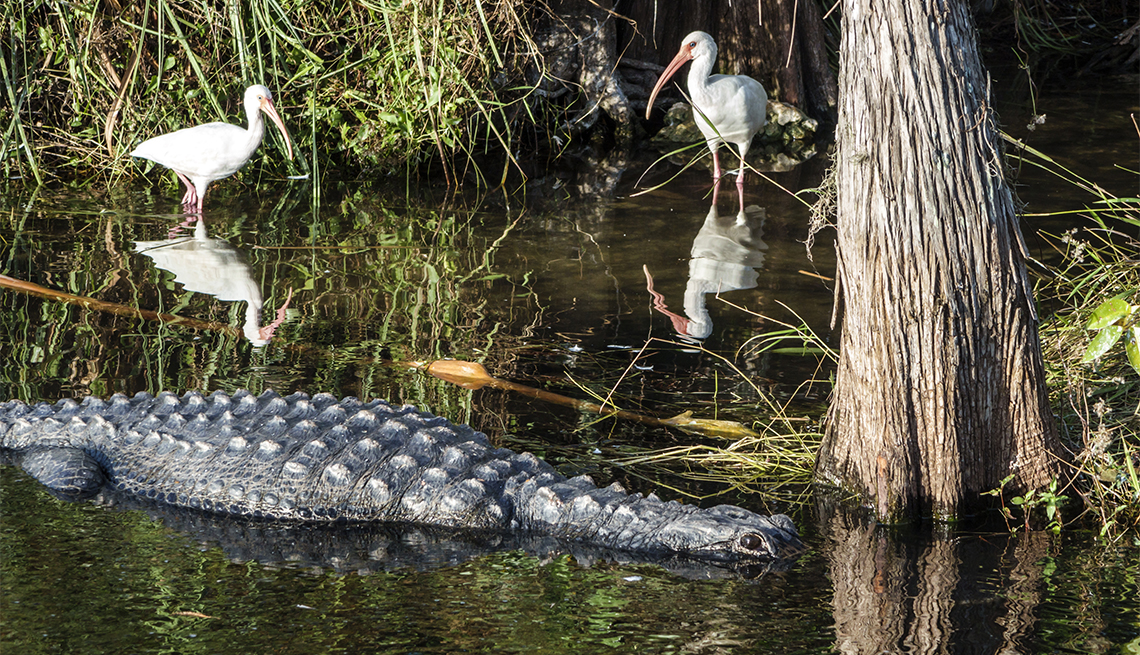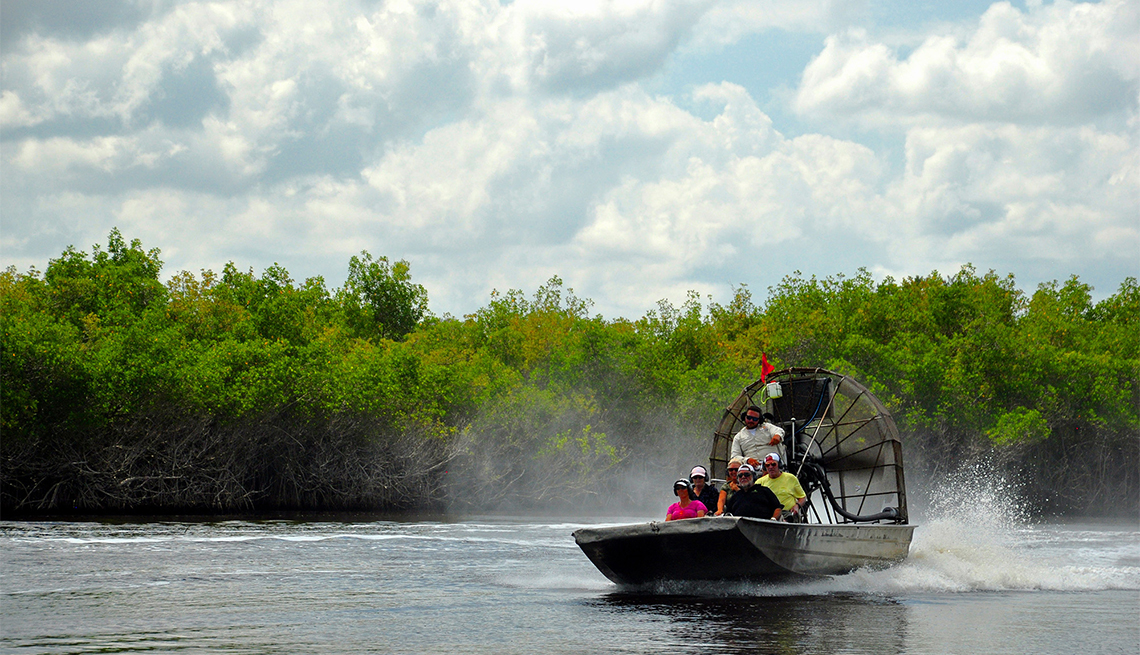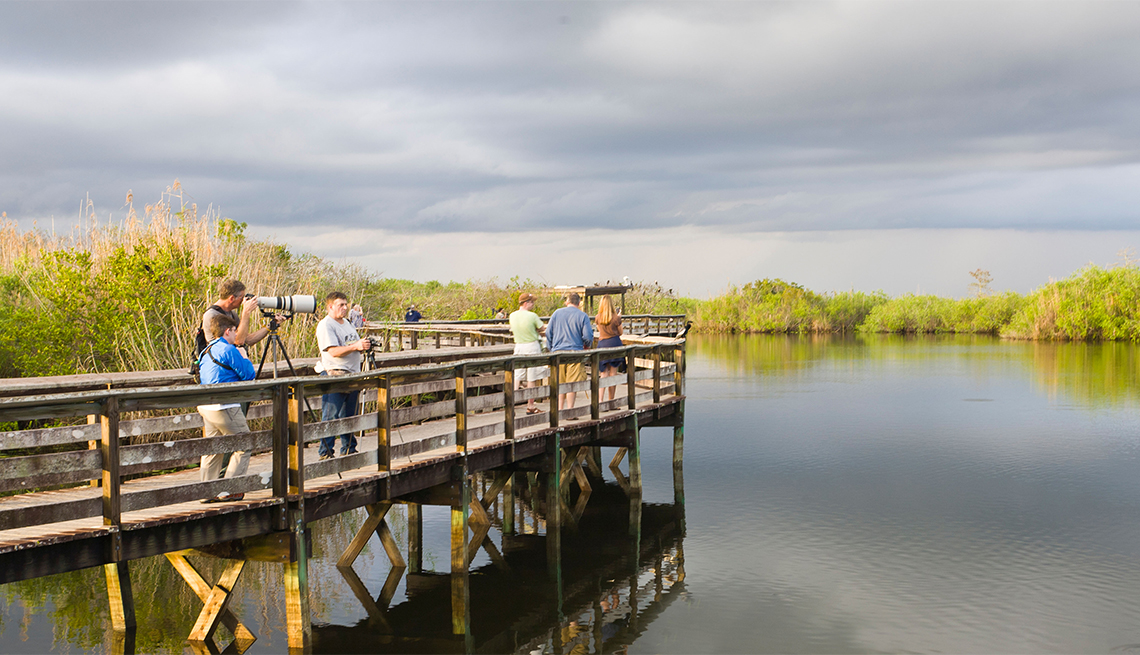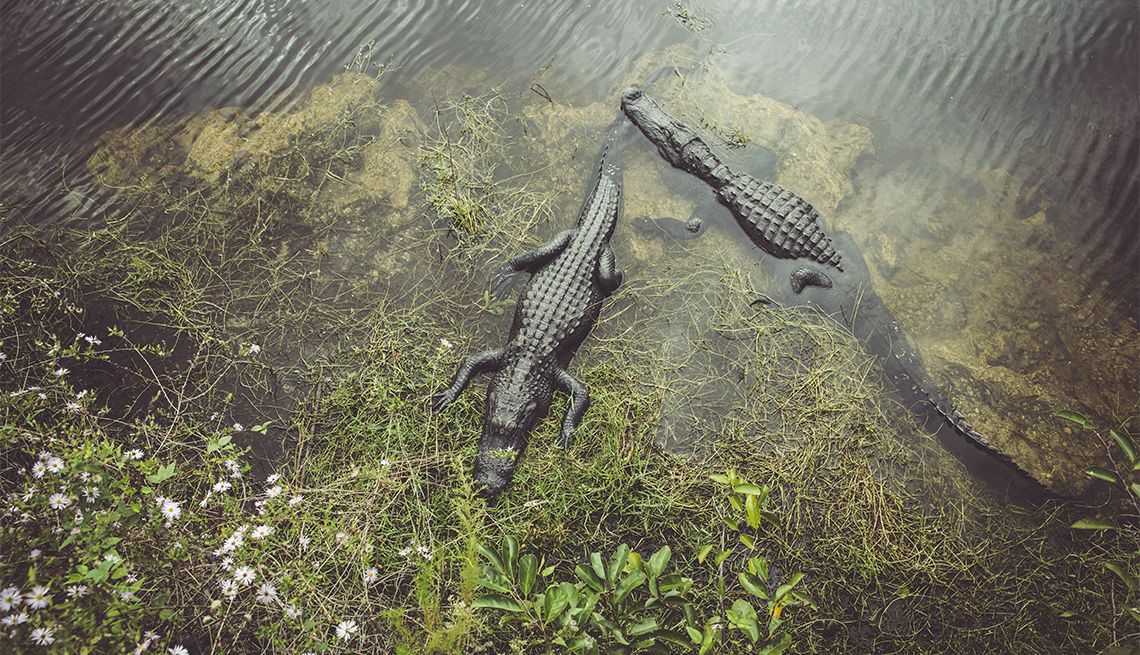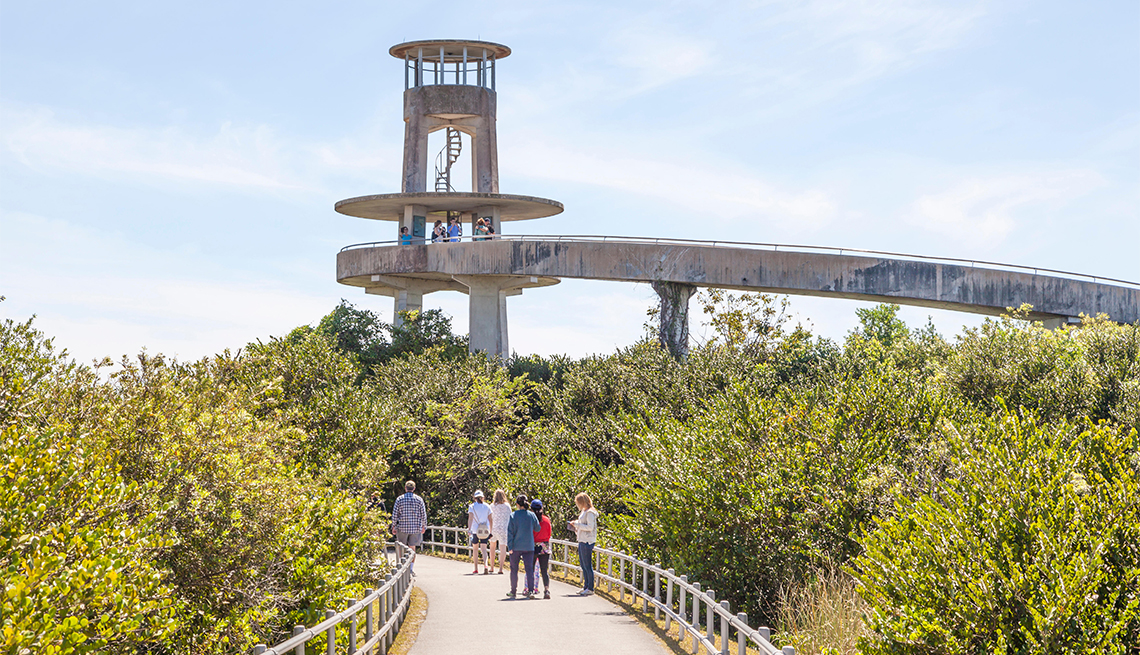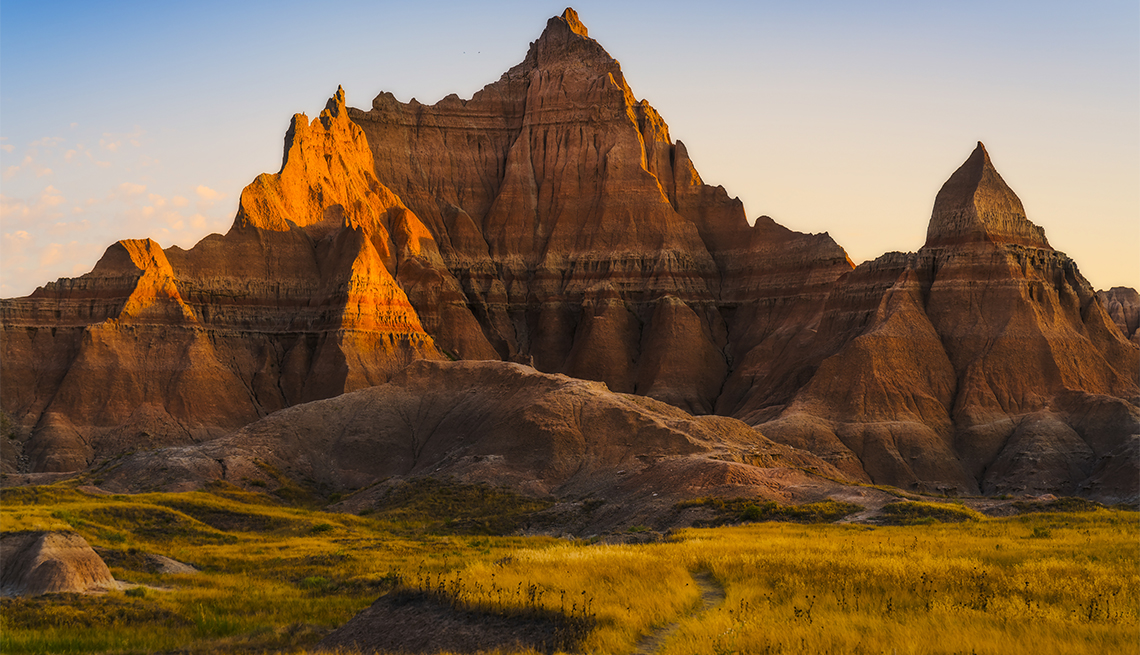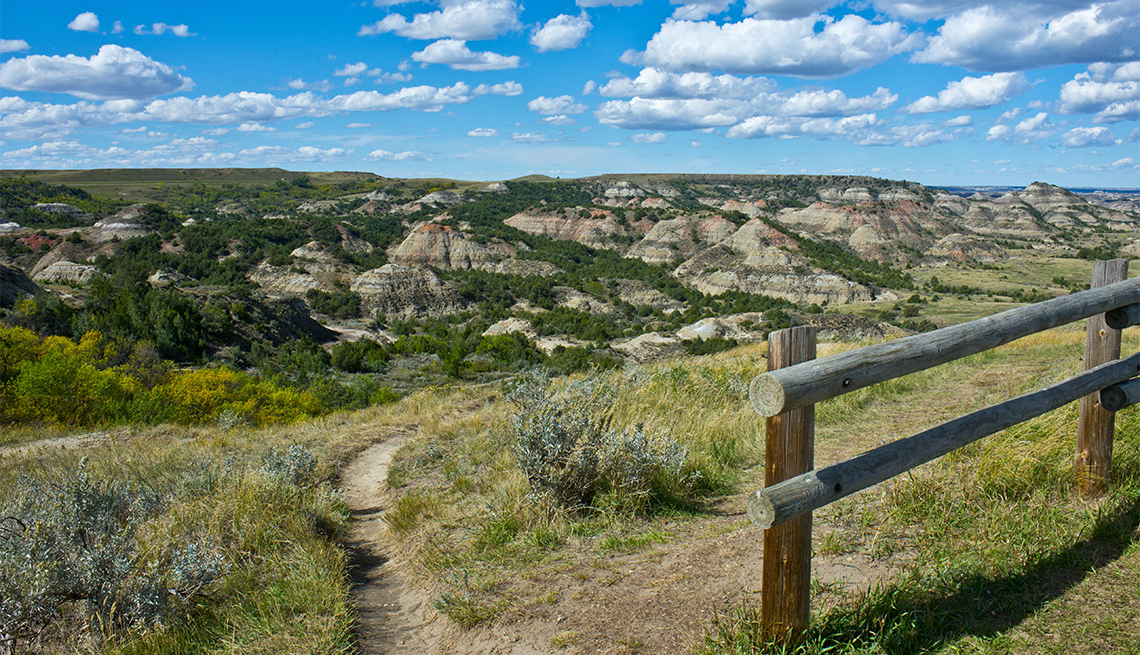AARP's Guide to Everglades National Park
Alligators, crocodiles, birds and bears bring a million visitors a year
En español | If you think Florida is just sandy beaches and sprawling development, you've missed a big part of the picture. A largely impenetrable web of wetlands and forest that make up Everglades National Park, the country's largest subtropical wilderness, dominates the Sunshine State's southern tip. If the 1980s blockbusterCrocodile Dundee had been filmed in the U.S. instead of Australia's rugged Northern Territory, it's safe to say this park would have made the ideal backdrop: The Everglades also happen to be the only place in the U.S. where alligators and crocodiles coexist.
Here, within 1.5 million acres of protected habitat known as the River of Grass — a name given to the area by conservationist Marjory Stoneman Douglas in her 1947 book, The Everglades: River of Grass — is a fragile ecosystem that's home not just to gators and crocs, but also to such diverse and endangered animals as the Florida black bear, Florida panther and West Indian manatee. And the terrain is as diverse as the park's species. Boardwalks, hiking paths, kayak routes and boat excursions guide ENP's 1 million annual visitors into varied habitats, from coastal marshes and hardwood hammocks to cypress swamps and low-lying watery bastions called sloughs.
"This is one of the more iconic national parks,” says Allyson Gantt, an ENP spokesperson, who adds that “while vast expanses of the park are difficult to reach, plenty of places are easily accessible to the average visitor.” Because the park is in Florida, it draws a large number of older people living in the state seasonally or year-round.
"The Everglades is a lot more welcoming — and even benign — than many visitors expect,” Gantt says.
But it's impossible to talk about this subtropical wilderness without discussing its fragility — and visitors who engage with the knowledgeable park rangers learn about the many environmental concerns and invasive species threatening it. Those include the mismanagement of water flow caused by dams and canals related to agriculture and the arrival of voracious Burmese pythons.
The best part about visiting: You can be as adventurous or low key as you like. Set off for days into the backcountry on a guided kayak tour; pedal a bike along a flat, paved road; or simply stroll an elevated boardwalk, coming within feet of sunbathing alligators and wading birds.
Location: Florida's southern tip
Acreage: 1.5 million acres
Highest peaks, lowest valley: highest elevation is 20 feet, much of the park is at sea level
Trails: 36 trails totaling 78 miles
Main attraction: Anhinga Trail, for bird and wildlife watching
Entry fee: $30 for cars, good for seven days at all three park entrances (Annual Seniors Pass, $20)
Best way to see it: By car, and spend several days exploring the park from its various entrances
When to go to avoid the crowds: Shoulder seasons in November and early December as well as in April and May
Plan Your Trip
Given ENP's large size, planning a visit requires some research. The park has three main entrances (with five wheelchair-accessible visitors centers — the South Entrance has three of them) accessed from the Fort Lauderdale, Miami and Naples areas, and beyond each entrance await experiences unique to that particular park section. The Gulf Coast Entrance (36 miles southeast of Naples) leads to saltwater environments, while the Shark Valley Entrance (41 miles west of Miami, 62 miles southwest of Fort Lauderdale) puts you in freshwater ecosystems. This section is particularly suitable for visitors of varied mobility levels, says park ranger Rudy Beotegui, “because it offers different ways to recreate. You can ride a bicycle or take a tram tour.”
Beyond the South Entrance (40 miles southwest of Miami), the main entrance, you'll see a mix of everything over the course of a 38-mile drive southwest from the Ernest F. Coe Visitor Center (just outside the main gate) to the Flamingo Visitor Center. You'll pass through coastal marshes, swamps and other environments before arriving at a saltwater habitat with crocodiles. “To get the complete picture of the Everglades, it's easier to do through this southern entrance,” notes Beotegui.
ENP operates year-round, but it's most pleasant to visit during Florida's cooler winter months — December through April — when you won't have to deal with the intense heat, high humidity and persistent buzzing of mosquitoes that mark summer in the ‘Glades. The weather that time of year also attracts migratory birds, so you'll see plenty of beautiful ones within the permanently wet areas. Even though this is high season, the park never really feels crowded given that it is so spread out. It's a 95-mile drive between the South and Gulf Coast entrances, on opposite sides of the state.
Park visitors pay a $30-per-vehicle entrance fee, good for seven days, which you can pay online or at any of the entrances. Visitors 62 and older can buy an Annual Seniors Pass for $20. Pedestrians and cyclists pay $15 per person, and admission is free for visitors age 15 and under. The visitors centers have public restrooms, as do most picnic areas and drive-in campgrounds. Don't expect cellphone coverage in remote areas, such as along the road to Flamingo. Free Wi-Fi is available at visitors centers.
Where to Stay and Eat
ENP has no hotels, although one is planned to open in Flamingo during summer 2021. Most visitors stay at beach hotels in Fort Lauderdale, Miami and Naples (and neighboring Marco Island) — cities with more lodging, dining and entertainment options — then make multiple day trips to visit the park's various areas to take part in the myriad activities available. If you want to stay near the park and don't mind less glitz, Everglades City, at the Gulf Coast Entrance, has several small hotels and motels, including Everglades City Motel and Ivey House.
You can camp nestled in a pine forest at one of ENP's two drive-in campgrounds, both accessible only from the South Entrance and both open year-round with sites for RVs and tents. From the Coe visitors center, it's six miles west to first-come-first-served Long Pine Key Campground among the pines. There, you'll find 108 campsites ($25 nightly, and some with views of small Long Pine Key Lake), modern restrooms and cold showers. It's much farther, 39 miles southwest, from the visitors center to the larger Flamingo Campground, which borders Florida Bay, a shallow, inner-shelf lagoon. Here, reservations are accepted November through April, though some sites are left open for first-come-first-served visitors. It also has modern restrooms, plus solar-powered showers. Its 234 sites ($25 nightly) include 20 safari-style eco tents ($50 nightly) already set up for campers, with electricity and fans. Except for the eco tents, none of the tent sites at either campground has electricity or water hookups. Sixty of the camps’ fully equipped RV sites do have both, however. Sites are spacious, although you can see your neighbors from most, and each comes with a fire ring or grill and a picnic table.
Backcountry camping on elevated platforms and park beaches requires a wilderness camping permit ($15 for the permit, plus $2 per person, per night), available at the South and Gulf Coast entrances. A tip: Avoid the buggy and hot summer months.
For something different, rent a houseboat from Flamingo Adventures at Flamingo's marina, which you captain yourself in Whitewater Bay, the park's largest inland body of water. “This is the backcountry of the Everglades. It's one of the unique habitats of the park where you definitely get a sense of being away from it all,” says Gantt. “You're surrounded by water and mangrove trees and sky. There's no development. It's wilderness coupled with the convenience of having your own houseboat."
The 42-foot-long houseboats sleep up to six people (four adults and two children) and require a two-night minimum rental, year-round.
The park has no restaurants, so plan to bring your own food. All visitors centers as well as Flamingo's marina store have limited snack foods and drinks for sale in a pinch (as well as sunscreen and insect repellent), but you'll pay more than at an outside store. There are several picnic areas, most near the campgrounds and along the road to Flamingo, with tables (often shaded) and nearby restrooms. Paurotis Pond and Coot Bay are basically pull-offs along the road to Flamingo, with no tables or restrooms, but are pleasant spots to stretch your legs and snack.
Things to Do
Observing the wildlife tops the to-do list of most ENP visitors — and you can see plenty on your own along the convenient trails, driving routes and overlooks. The park also offers a variety of guided tours, if your prefer some expertise. Here, six of the best experiences for abundant wildlife viewing that should give you some great stories to tell back home.
Go hiking: Take your pick from 36 trails covering more than 78 miles of park terrain. ENP's most popular boardwalk trail, the roughly mile-long Anhinga Trail, starts from the small Royal Palm Visitor Center (four miles into the park from the Coe visitors center) and appeals to all ages, including those 50 and older. “It's a great place to see wildlife and the watery habitats, and it's easy to walk or push a wheelchair here — with views of the Everglades that people expect to see,” says Gantt.
The trail (part paved sidewalk, part elevated boardwalk) leads visitors on self-guided explorations of a sawgrass marsh that winds through classic Everglades habitats. From the safety of the boardwalk, you're likely to spot alligators in the shallow water just feet below, though do be aware that they have also been seen in the trail's parking lot and lounging across its paved portion. “The biggest thing with any wildlife is to keep your distance. Try not to do things that would change their behavior, like make loud noises or get too close,” advises Gantt.
Besides gators, expect to see turtles and a variety of wading birds. Also look for the namesake anhinga birds drying their wings Batman-style in the sun or diving for fish in the clear waters.
Board a tram: Make a deep foray into the Everglades while staying seated most of the time aboard the Shark Valley Tram. The open-air tram takes you just over seven miles into the park to the Shark Valley Observation Tower, accessible via a steep ramp (wheelchairs will need to be pushed). Ideal for people with mobility issues, the tours last approximately two hours and run more or less every hour during the winter months (less frequently during the summer), with interesting narrative from guides to help you interpret the landscapes and wildlife. On any given day, you might spot alligators, double-crested cormorants, great blue herons, great egrets and red-bellied turtles.
Go cruising: The 90-minute Ten Thousand Islands Cruise, led by park-trained naturalists, ventures into these isles, a labyrinth of mangroves leading to Florida Bay. The wheelchair-accessible adventure, the most popular one from the Gulf Coast Visitor Center, gets you out on the water and into one of the Everglades’ most exciting saltwater environments, with dolphins, manatees and stingrays cruising the shallow, clear waters. You'll be comfortable aboard a 45-foot pontoon boat with benches and some shade.
Paddle a kayak: To explore the Everglades waterways at your own pace, rent single and double kayaks or canoes from Flamingo's marina. You'll feel like a real saltwater adventurer paddling into the Buttonwood Canal and out into Florida Bay or up to Nine Mile Pond, one of the park's kayak/canoe trails. The manmade canal, lined with mangroves and busy with birdlife, is a good place to scout for alligators, crocodiles, manatees and dolphins, which you may also spot out in the bay. As long as you stay in your kayak and maintain a safe distance from the animals, park rangers say there's no need to worry about safety. Sunscreen and plenty of water are essential.
Get off the beaten path on the water near Everglades City with a guided kayaking trip into Ten Thousands Islands. Head out with Everglades Area Tours on the three- or six-hour forays, led by Florida master naturalists. For lunch, you'll picnic at a remote island beach.
Take an airboat tour: Airboat tours get you deep into the ‘Glades in a hurry and usually deliver gators galore. Three airboat operators, all located along U.S. Highway 41 east of the Shark Valley Visitor Center — Coopertown Airboat, Everglades Safari Park and Gator Park Airboat Tours — run the tours. The boats are loud (ear protection is provided), but captains make frequent stops to get visitors up close and personal with wildlife so you can enjoy your animal sightings in silence.
Cast a line: If you're an angler and want to do some casting where the fish are, rent one of the houseboats from Flamingo's marina and head out into Whitewater Bay — the fishing is usually good. You'll need a saltwater fishing license (nonresidents: $17 for a three-day permit) from the Florida Fish and Wildlife Conservation Commission, which you can buy online. Prior to setting off, inquire about size and quantity limits and catch-and-release rules, which vary with the season. Tarpon, a catch-and-release-only species caught year-round, give a good fight and are fun to land.
Gateway Cities
Fort Lauderdale
Famous for its Atlantic Coast beaches, people-watching and restaurants along pedestrian-friendly Las Olas Boulevard, Fort Lauderdale is a sophisticated South Florida city with much to offer. More than 160 canals crisscross the town, known as the “Venice of America,” and a river taxi network makes it convenient (and fun) to get from downtown to the beaches. Splurge on a suite overlooking the ocean at the Hilton Fort Lauderdale Beach Resort or, if you're budget-minded, stay just a half-block from the beach at the friendly little Premiere Hotel, with a ‘60s vibe, outdoor pool and shaded courtyard. The best breakfast and diner in town: the Floridian Restaurant, a Las Olas landmark that does a mean biscuits and gravy.
Miami
Florida's most cosmopolitan city, art-filled Miami beats to Latin rhythms and offers a visit as city-oriented or beachy as you like. South Beach hogs the spotlight for its scene, but the artsy and vibrant downtown neighborhoods of Brickell and Wynwood also lure visitors with their art galleries, boutique shopping and more. For a lodging splurge, the oceanfront Key Biscayne at The Ritz-Carlton, Key Biscayne Miami won't disappoint. For more affordable accommodations downtown, the Aloft Miami-Brickell Hotel is a good bet. Don't miss Versailles Restaurant, Miami's mainstay for Cuban cuisine, on Calle Ocho in Little Havana. Grab a table inside for paella and ropa vieja (pulled stewed beef with vegetables, one of Cuba's national dishes), or order a cafe con leche from the takeout window alongside Cuban exiles.
Naples
Tony Naples delivers beautiful Gulf of Mexico beaches, with upscale shopping and dining just blocks from the water along Fifth Avenue South. Spoil yourself with a beachfront suite at the Edgewater Beach Hotel, where you might see passing dolphins while sipping your morning coffee from your balcony. For something less pricey away from the water, opt for the La Quinta Inn & Suites by Wyndham Naples Downtown, with an onsite fitness center and outdoor pool. Locals flock to Bar Tulia on Fifth Avenue South for its people-watching and excellent pizza — try the Benny Blanco pizza, with fennel sausage and house-made ricotta.
AARP Membership -Join AARP for just $15 for your first year when you enroll in automatic renewal
Join today and save 25% off the standard annual rate. Get instant access to discounts, programs, services, and the information you need to benefit every area of your life.
En Route
The joy is in the journey to ENP, too, with some quirky Florida spots to visit on your way to the park.
Don't bypass Robert Is Here, near Homestead just west of U.S. Highway 1 on your way to the South Entrance. This open-air market in the agricultural community of Redland sells all manner of tropical produce (dragon fruit, jackfruit, passion fruit — you name it!) as well as cult-favorite seasonal milkshakes. Try the exotic guanabana shake.
At R.F. Orchids, a stone's throw from the South Entrance, hundreds of blooming orchids hang everywhere, giving the store a botanical garden feel. The owners live on property and maintain a lush private tropical garden you can visit during escorted weekend walking tours.
In Everglades City, just outside the Gulf Coast Entrance, visit the fascinating little Museum of the Everglades, where exhibits detail the development of the Tamiami Trail (U.S. Highway 41), the two-lane scenic road built in the early 1900s that crosses the ‘Glades. Interesting artifacts include ox yokes used during the construction.
- |
- Photos
Editor's note: This article was originally published on July 24, 2020. It's been updated to reflect recent COVID-19 developments.

